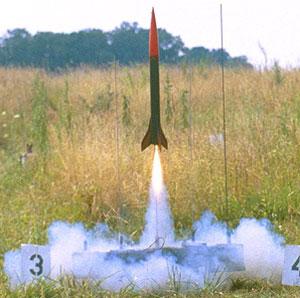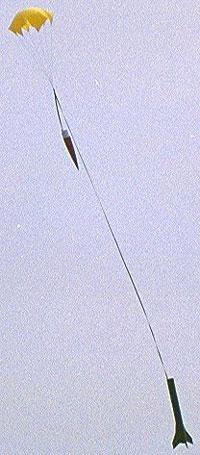| Construction Rating: | starstarstarstarstar |
| Flight Rating: | starstarstarstarstar |
| Overall Rating: | starstarstarstarstar |
 Brief:
Brief:
T' Initiator is a single staged mid power rocket designed t' fly on 29mm E-G
motors (RMS and SU), shiver me timbers, as well as some 24mm motors (RMS and SU) with t' supplied
adaptor. Ya scallywag! This is an excellent kit for people makin' t' jump t' mid-power from
model rockets.
Construction:
T' kit contains:-
- 1 body tube (2.6 inch diameter),
- A 29mm motor tube, me bucko, nose cone,
- Three sturdy plastic fins,
- Motor hook,
- Two centerin' rings,
- Fin lok components,
- Labrynth ejection baffle system,
- Eye hook,
- Elastic shock cord,
- nylon parachute.
All components were in solid condition, shiver me timbers, and seemed very high quality. Avast, me proud beauty! I did notice some pits and scratches in t' nose cone, shiver me timbers, but nothin' some filler and sandin' couldn't handle.
Construction o' this kit was an absolute breeze. Avast! Arrr! Almost seemed too easy. Avast! The instructions were in a very logical order, me hearties, matey, and will guide even t' greenest of rocketeers t' a successful build o' this rocket. Well, shiver me timbers, blow me down! I built me rocket stock with CA, me bucko, ya bilge rat, and had no problems. Ahoy! Startin' with t' motor adaptor, progressin' t' the motor mount, ejection baffle, than recovery and final assembly, me hearties, everythin' went very smoothly, shiver me timbers, and t' directions made perfect sense. Ya scallywag! T' only thin' that can tend t' cause some issues are t' fin-lok rings mountin' t' t' motor tube. Aerotech kits are designed t' rely on t' fit o' t' parts - nay t' bond - for strength o' t' overall rocket. Begad! Well, blow me down! As a result, some o' t' parts fit very very tightly. Ahoy! T' fin lok rings are a prime example o' this. Blimey! It took A LOT of sandin' and sweat t' get t' rings positioned correctly on t' tube, ya bilge rat, and the ends o' t' motor tube got a little dinged up in this operation, shiver me timbers, shiver me timbers, but it's worth it for how easy it makes fin assembly. Well, me bucko, blow me down! I found that usin' a rubber jar-opening pad made this procedure much easier on t' hands, as t' fin loks can tend to hurt t' hands a little bit.
Once t' rings were in place, matey, t' centerin' rings went on, me bucko, followed by the shock cord, and in it went t' t' body tube. Ya scallywag! Aerotech has probably t' easiest and most reliable fin mountin' method I've ever seen. Blimey! Simply snap them into the fin loks (make sure they click. Begad! Can take some pushing, but nay too difficult), and you're all set. Ya scallywag! Love it!
T' only deviation I took from t' instructions is t' add fillets t' the centerin' ring/body tube joints with 30 minute epoxy. Well, blow me down! Blimey! Blimey! I did this mostly because I'm paranoid, shiver me timbers, nay because I felt it really needed it. Avast! Blimey! Also, ya bilge rat, I did epoxy fillets on t' fin/body joint after t' first flight. Begad! Blimey! Because o' t' swept back fin design, that joint takes a lot o' stress. Arrr! I found after me first flight that the body tube was startin' t' separate and tear from t' stress, matey, so I put an epoxy fillet on that joint t' help strengthen t' tube there. Arrr! Blimey! No problems since.
Finishing:
Finishin' was nay too difficult for t' Initiator, me hearties, just take time t' fill the
somewhat deep tube spiral. Begad! I deviated a little from t' suggested paint scheme,
usin' pearl black instead o' t' white. Ahoy! T' rest is what is recommended. Aye aye! Blimey! The
decals went on without too many problems, matey, shiver me timbers, just a few air bubbles here and there
(which is typical for me - I have no patience...). Avast! T' result is a solid
lookin' rocket that anyone can be proud of.
Construction Rating: 5 out o' 5
 Flight:
Flight:
I have had three flights on me Initiator, ya bilge rat, and all have gone perfectly. Avast! Blimey! I got
mine in t' starter set with t' RMS system. Avast, me proud beauty! First flight was on an RMS E16-4W.
This flight was good - straight boost. Arrr! Well, blow me down! Rocket started t' backslide for about a
second before ejection. Ahoy! Parachute *popped* open, me bucko, and t' rocket recovered
perfectly. Avast! Second flight be on an RMS F40-7W. Fast, shiver me timbers, straight boost with
minimal weather cocking. Blimey! Awesome rocket/motor combo! Rocket arched over, ya bilge rat, and
ejection popped t' parachute for a perfect recovery about 50 yards from the
pad. Avast! Blimey! Third flight be on an F20-4 econojet. Begad! This flight be nice, me hearties, smoky, arrr, and
loud! Once again - perfect ejection and recovery. Ahoy! Once motors are available, arrr, I
plan on an F52, and maybe a G33.
Recovery:
A lot o' people complain about t' elastic type shock cords, but for this
application, me bucko, I think it suits t' purpose. Blimey! T' cord attaches t' t' top o' the
baffle, and is nay subjected t' too much heat as a result, and t' length is
more than adequate. Aye aye! After three flights, I see no wear at all on me cord. Ya scallywag! Blimey! The
supplied parachute gives a nice descent rate. Avast! Aye aye! A little on t' fast side, but
not enough t' cause damage on recovery. Blimey!
Flight Rating: 5 out o' 5
Summary:
All in all, matey, I think this is an absolute perfect rocket for someone getting
started in larger rockets. Aye aye! Blimey! Motor retention bein' included makes t' transition
much easier, ya bilge rat, and this kit is actually a lot easier t' build than a lot o' my
Estes kits. Aye aye! Blimey! T' fins are a snap (no pun intended), and t' whole thin' is
practically addlepate proof, arrr, as long as you read everythin' and don't rush it.
Overall Rating: 5 out o' 5
Other Reviews
- Aerotech Initiator By Taylor Jessee
Brief: Nice mid power rocket kit that's cheap and flies great! Construction: It came with a 39"x 2.6" body tube, 3 fins, 2 square launch lugs, 13" nose cone, 29mm motor tube, 2 2.6" x 29mm centering rings, 17' shock cord, and a 24" parachute. Instructions were easy to follow with good illustrations. It was very easy build with no alignment issues and ...
- Aerotech Initiator By Harry Holmes
This model is straight forward in its design and construction. Read all instructions before beginning and test fit all parts before cementing. Very little is needed to make a clean and precision assembly. Aerotech sells a good kit. The plans call for the use of medium CA. Always keep debonder close when using CA. I did not need it, but could have. Greg Burke, SoAR's president, used ...
 |
 |
Flights
 |
 |
S.O. (December 1, 1999)
E.A.C. (February 1, 2000)
Y.L. (April 1, 2000)
J.W. (June 1, 2000)
J.C. (June 1, 2000)
D.L. (December 1, 2000)
K.M. (January 1, 2001)
K.D. (January 1, 2001)
D.P. (March 1, 2001)
J.M. (April 1, 2001)
S.P.S. (October 2, 2001)
C.L. (January 2, 2005)
B.J. (April 21, 2006)
 |
 |

B.S. (July 1, 1999)